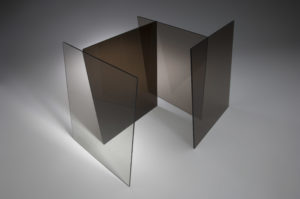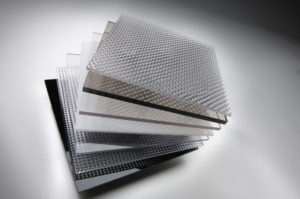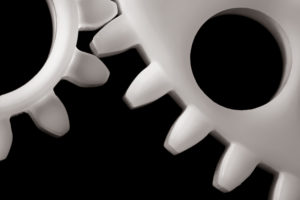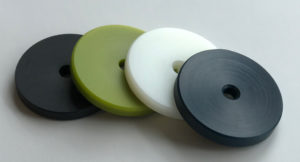Plastic Materials
There are hundreds of types of plastics, each with their own characteristics, traits, and tolerances. Plastics can be classified as Amorphous or Semicrystalline based on their chemical makeup. The organization of each material’s polymer chains has a direct impact on its performance. How those molecular chains are organized defines its characteristics and capabilities, which makes them better for different end uses.
Amorphous Polymers
Amorphous plastics are a type of polymer possessing a disorderly, intertwined molecular structure. Their molecular chains are random and mixed, leading to a very spaghetti-like composition. Due to this lack of structure, they tend to be more flexible, and soften as temperatures rise.
These plastics tend to be translucent in color and have good dimensional stability. Due to their loose and random molecular structure, they tend to lack the mechanical strength semicrystalline polymers have.
Benefits of Amorphous Plastics
- Often transparent or translucent: Great for applications involving light, optical clarity, or visibility.
- Low shrinkage: Amorphous materials tend to not shrink as much as their semicrystalline counterparts.
- Easier to process and thermoform: Disorganized molecular structure makes them easier to form and shape with heat.
- Better dimensional stability: Better at retaining their shape as they are bent, warped, or processed.
- Enhanced bonding capabilities: Improved bonding properties; generally better with glue, paint, etc.
Disadvantages of Amorphous Plastics
- Low wear resistance: Their loose and disorganized molecular structure makes them less capable of enduring lots of wear.
- Less reliable in high-heat applications: Amorphous materials’ viscoelastic properties make them less reliable in applications involving high temperatures.
- More prone to stress damage and fatigue: Lower resistance to wear reduces amorphous plastics’ ability to bear heavy loads.
Amorphous Polymer Examples
- Acrylic (Polymethyl methacrylate, PMMA)
- Acrylonitrile Butadiene Styrene (ABS)
- Polycarbonate
- Polyethylene Terephthalate Glycol (PET-G)
- Polystyrene
- Polyphenylene Oxide (PPO)
- Polyphenylsulfone (PPSU)
- Polysulfone (PSU)
- Polyvinyl Chloride (PVC)
- Thermoplastic Polyurethane (TPU)
Semicrystalline Polymers
Semicrystalline plastics have tightly packed, organized molecular chains. Their molecular chains are much more organized than their amorphous counterparts and have much stronger chemical bonds. Their strong intermolecular forces make semicrystalline plastics highly durable materials.
These plastics have a sharp melting point, meaning they remain solid at all temperatures below that temperature. Once they reach their melting point, their properties immediately begin to drop off. Unlike their amorphous counterparts, these materials do not gradually soften or transition into liquid as heat is introduced. Semicrystalline polymers are generally tough, stiff, and opaque in appearance.
Benefits of Semicrystalline Plastics
- Generally more durable: Semicrystalline materials’ ordered molecular structure leads to a tough material that can handle heavy loads.
- Better wear properties: Semicrystalline polymers tend to have a lower coefficient of friction.
- Generally better in the heat: Semicrystalline materials’ properties generally make them more consistent and reliable in high-heat applications.
- More chemically resistant: The orderly and tightly-packed molecular chains make them more resistant to prolonged chemical exposure.
Disadvantages of Semicrystalline Plastics
- More difficult to produce: Due to their heat resistance and sharp melting point, these materials require a more rigorous manufacturing process. From thermoforming to plastic injection molding, semicrystalline materials are tougher to produce.
- More prone to shrinkage: Semicrystalline plastics’ molecular structures tend to shrink. The degree of shrinkage depends on the specific material and alignment of the polymer chains.
- Lower bonding capabilities: Overall, amorphous materials have better adhesive qualities than semicrystalline.
- Low flexibility: Due to their strength and durability, semicrystalline materials tend to be stiffer, giving them less elasticity.
Semicrystalline Polymer Examples
- Acetal (Polyoxymethylene, POM)
- Polyethylene Terephthalate (PET, Polyester)
- Polybutylene Terephthalate (PBT)
- Polyethylene (LDPE, HDPE, UHMW, etc.)
- Polypropylene
- Nylon (Polyamide, PA)
- Polyphenylene Sulfide (PPS)
- Fluorinated Ethylene Propylene (FEP)
- Polyvinylidene Fluoride (PVDF)
- Polytetrafluoroethylene (PTFE)
- Polyetheretherketone (PEEK)
What is the Difference Between Amorphous and Semicrystalline Plastics?
The difference between amorphous and semicrystalline polymers is within their molecular structure. The molecular chains within semicrystalline material are more organized and structured, while the molecular chains in amorphous materials are entangled and disorganized
This important molecular difference gives them contrasting qualities. Semicrystalline plastics have a specific melting point, and generally remain solid until exposed to this melting point. Meanwhile, amorphous plastics tend to gradually soften as heat increases.
Is One Better Than The Other?
Industries around the world harness the capabilities of both types of polymers. However, depending on the end use, one type may be better than the other. Semicrystalline polymers, for example, are better for structural, weight-bearing applications. Their strength, stiffness, and rigidity allow them to handle heavy loads and elevated temperatures. These materials also do not wear as fast as amorphous alternatives.
Amorphous polymers are more common in applications that require a material that is easier to bend. They also handle paint, glue, and other adhesives much better than their semicrystalline counterparts.
Invest in Amorphous and Semicrystalline Plastics with Polymershapes (H2)
Polymershapes is North American’s leading distributor of both amorphous and semicrystalline plastics. Our in-depth selection process (link to Material Selection blog) will ensure you get the best plastic for your needs. We have the inventory, partners, and product knowledge to find the most effective solution. To learn more about our inventory of amorphous and semicrystalline plastics, contact us today.



